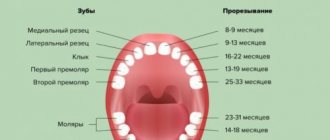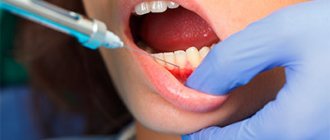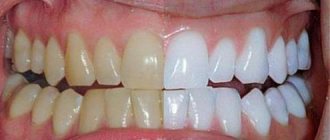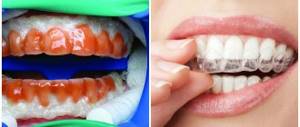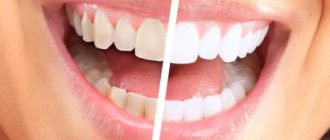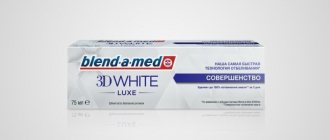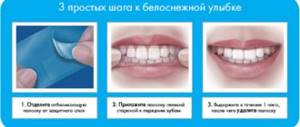Briefly about the types of whitening
Modern dentistry offers options with which you can lighten the enamel up to 10–12 tones. Let's list them:
| Whitening method | Peculiarities | How many shades does the enamel lighten? | Time spent in the dentist's chair |
| Laser | The most expensive, but one of the most effective methods that can eliminate even the unpleasant yellow tint of “tetracycline” teeth | 10–12 tones | About an hour |
| Photobleaching | A gel is applied to the enamel, which is then activated using ultraviolet, halogen or LED lamps. Within this method, popular technologies are ZOOM, Amazing White, Luma-Arch, Beyond Polus | 6–12 tones | 45–60 minutes. The gel is applied up to 6 times in a row in several approaches (10–15 minutes each) |
| Chemical | Activation of bleaching components is carried out using chemical reagents. Quite an aggressive technique, but affordable. One of the most popular technologies today is Opalescence | 4–5 tones | From 15 to 60 minutes |
| Cosmetic Magic White | A relatively new and very inexpensive method. The creators claim that the procedure is so simple that it does not require a professional dentist, and all manipulations can be easily performed by a cosmetologist. | For 4–121 tones | From 20 to 60 minutes |
Helpful advice! If you are for naturalness and just want your teeth to look well-groomed and natural, then do professional hygiene with Air-Flow and ultrasound instead of whitening. This is the most gentle and safe way. During the procedure, the doctor will remove all types of plaque and deposits localized on the teeth, gums and under them. A nice bonus is that the enamel is lightened by 1-2 tones.
Things to remember before any whitening procedure
- If you want the effect to be maximum, then before the procedure it is necessary to carry out professional cleaning. During the process, the specialist will prepare the teeth: remove plaque, make the surface even, smooth and susceptible to further exposure to lightening agents. Whitening can be carried out no earlier than 7–14 days after professional hygiene - during this time the enamel and gums will be restored.
- Two weeks before the session, it is necessary to begin strengthening the enamel with pastes with fluoride or calcium, and undergo a course of remotherapy or fluoridation. It is important to diversify the menu and add to the diet all groups of vitamins and microelements that are beneficial for teeth and gums - B, C, E, D, K, calcium, fluorine, phosphorus, iron, zinc. The lack of vitamins in food can be compensated with vitamin-mineral complexes.
- It is necessary to cure caries and all damaged teeth, stop the inflammatory process on the mucous membrane, if any.
- Immediately before the procedure, you need to eat, because after it it is not recommended to do this for 2-3 hours.
But you can change artificial crowns and old fillings only after whitening. Remember that composites and other materials (such as ceramics) cannot be lightened. The previous color of the structures will remain, and it is unknown whether it will match the new shade of your enamel.
Important! Not all teeth can be whitened. It will not be possible to achieve significant success if the enamel and the underlying dentin are naturally gray in color. Professional (and especially home) methods will not cope with severe fluorosis2 and hypoplasia. For the listed pathologies, it is better to choose an alternative - veneers or lumineers, crowns.
Changes in enamel color in smokers
In the process of smoking a cigarette, smoke enters the human body, which contains tar, nicotine and combustion products. They stick tightly to tooth enamel, staining it an unnatural color. Smokers often have yellow or brown teeth. In this case, localized areas of enamel staining in the form of spots or lines may be observed, indicating the most affected areas.
Features of stains on enamel:
- in the spaces between the teeth - a sign of the formation of tartar, which accumulates a greater amount of coloring substances due to its porous structure;
- along the gum line - a sign of recession, characterized by weakening of the gums, exposure of the neck of the teeth and inflammation of the soft tissues;
- the inner side of the dentition - signals an increased acidic environment as a result of the interaction of saliva and cadmium sulfate (a product of burning a cigarette), the formation of tartar and inflammation of the gums.
Long-term smoking leads to the penetration of dyes deep into the tissue of the dental crown. Not only enamel is negatively affected, but also hard tissues up to dentin. Therefore, the only solution to restore a snow-white smile is professional whitening.
How long does the result actually last: expert opinions
If you do teeth whitening, how long does the effect last? Doctors note: the more the enamel was lightened, the longer the effect could potentially last. If the procedure was carried out using professional methods in a dentist’s office, then on average the result will please you for 3-4 years, but only on condition that you perform good oral hygiene and follow a number of rules, which we will definitely discuss below.
“Teeth cannot be whitened once and for all - such an effect cannot be achieved today by any method known to dentists. But a decent result can really be maintained for many years after whitening if you take very good care of your oral cavity and follow all the doctor’s recommendations,” says O.A. Belyaeva, dental hygienist.
Some doctors argue that with proper and careful care, a return to the original shade of the enamel cannot occur, but it will still gradually darken from the accumulation of plaque, which will periodically have to be removed with the help of professional oral hygiene. In addition, every person drinks tea, possibly coffee, and eats foods that change the color of the enamel.
Important! Professional doctors do not advise overusing whitening procedures and doing them more than once a year. Otherwise, you can greatly weaken the enamel and make it even more susceptible to external factors, including staining.
As for patients who do not whiten the enamel using professional methods, but have returned its natural color with professional hygiene, the effect after the procedure can last for 6 months. But after six months (or a year), it will still have to be refreshed, because even non-smokers and people who take good care of their teeth gradually accumulate mineralized plaque, which is difficult to get rid of without the help of professionals.
Teeth whitening
Every person who dreams of a beautiful smile can achieve their goal if they visit pain-free cosmetic teeth whitening at our clinic in St. Petersburg. Although this procedure has been used relatively recently, it has already gained popularity. Below we will look at what cosmetic teeth whitening is and what types of this procedure there are.
Initial examination
By contacting us, you can have in-office teeth enamel whitening using the Opalescence, Air Flow and any other methods. We are attentive to the problems of our patients, so we always try to take into account all the nuances when prescribing a procedure. Our specialist will carefully conduct an initial examination, identify all factors that may affect treatment, and also recommend a safe and effective method specifically for you.
Diagnostics for teeth whitening
When prescribing one or another whitening method, a thorough diagnosis will be carried out. We use the most modern equipment, so if necessary, we will take a computer image and also determine if there are carious lesions on the teeth.
Prevention
In order for plaque to appear on the enamel to a lesser extent, you should consume colored drinks and foods as little as possible, and also stop smoking, including hookah. Also, do not forget to visit the dentist once every six months for a preventive examination.
Modern methods of teeth whitening in dentistry
Teeth whitening methods in dentistry can be divided into two main groups of procedures. One group is usually called “professional” - they can only be used in a dental clinic. The second is often called “home whitening” - it is carried out independently, at home, using a tray and a special gel.
First, let's understand their differences in detail, and only then consider which methods and methods of teeth whitening are the safest and most effective.
Experts identify several main differences between home and professional methods:
- Firstly, a professional procedure is carried out using special devices, and is done by a doctor in a clinic, while at home you will carry out it yourself, according to the doctor’s instructions.
- Secondly, an in-office procedure, as a rule, allows you to whiten your teeth quickly and achieve a more significant effect that lasts longer than the result obtained with home whitening.
Now let’s figure out how professional teeth whitening is done in our dental clinic in St. Petersburg, what types of procedures there are and what their cost is.
Teeth whitening with Zoom system
This method involves the use of a special photographic device, or, as it is also called, a UV lamp. Let's talk a little about how light teeth whitening using a UV lamp occurs, what indications and contraindications this procedure has, and how long the effect lasts.
The lamp emits ultraviolet light, which affects the gel previously applied to the enamel. Which, in turn, using a chemical reaction caused by the action of ultraviolet rays, lightens the enamel. This is how teeth whitening occurs with the Zoom system.
The advantages of the method include its painlessness, and the fact that the effect of the procedure lasts about 5 years.
It is worth noting that not all people can use this method. Firstly, Zoom whitening should not be used if the patient has caries, and secondly, it cannot be used during pregnancy or breastfeeding. In addition, sometimes allergic reactions to the gel make the method inapplicable to a particular patient.
You can find out how much professional gentle teeth whitening Zoom costs on average in our clinic in St. Petersburg, and its exact price specifically for your case, from our dentists. Our doctors will determine the need for this procedure and the amount of work.
Laser teeth whitening
Teeth whitening using laser is already well known to many clients of our aesthetic dentistry center. For those who are not yet in the know, we will tell you how this procedure is carried out, what advantages and disadvantages the method has, what the cost of laser teeth whitening is, its pros and cons, and also what the price of it depends on.
The procedure begins with the patient applying a special gel to the patient’s tooth enamel, which is “activated” using a laser beam. Whitening one tooth takes about 1–5 minutes, depending on the degree of darkening. Because of this variation, how much does in-office laser teeth whitening cost at a dentist in our clinic in St. Petersburg depends not only on the price of the drug used, but also on how intense the whitening is required.
Laser teeth whitening has its pros and cons. The main advantage is that it takes on average only 20–30 minutes. The downside is that it can damage the enamel if performed by inexperienced specialists. At the same time, the laser heats the tooth significantly less than a UV lamp, and therefore the risk of damage is lower.
The effect after lightening the enamel lasts for at least 1–2 years, depending on whether the person smokes and how often they drink coloring drinks, such as coffee.
Experts note that laser teeth whitening in dentistry cannot be performed during pregnancy and for young mothers who are still breastfeeding.
Laser teeth whitening for those wearing braces
This whitening method is recommended for those who wear or have worn braces. After removing them, dark spots may remain on the enamel, which should be removed. The laser method, which is a safe teeth whitening technique, is great for people with braces. It will help quickly whiten your teeth after removing braces and give your smile beauty and shine.
If braces are still on the teeth, whitening is only possible if the brackets are installed inside.
Chemical teeth whitening
This procedure is also performed in the clinic. When whitening teeth using a chemical method, a special gel is applied to the teeth under a mouth guard, which is much more active in terms of impact strength than the gel for more gentle home whitening. Therefore, before using it, possible contraindications should be taken into account. For example, chemical whitening is not recommended if there are fillings on the front teeth.
Air Flow Teeth Whitening
“In-office” teeth whitening using the Air Flow method is also quite popular, so let’s look at how it happens.
This method has significant differences from those described above. Firstly, when using this procedure there is no need to apply a special gel, and secondly, when using it, the whitening effect is obtained due to the fact that the teeth are cleaned of plaque, and not due to the lightening of the enamel itself.
In order to remove plaque, a special sandblasting machine is used. It delivers a soda solution under pressure - a safe and non-toxic substance.
Ultrasonic teeth whitening
Currently, many dental specialists recommend this method of safe teeth whitening. During the procedure, a special ultrasound device is used, the power of which is adjusted by a specialist for a specific patient.
The undoubted advantage of the method is that ultrasound allows you to whiten teeth, while completely preserving the integrity of the enamel, since the likelihood of damage to it by ultrasound is negligible compared to other methods. That is, this procedure is one of the safest methods of teeth whitening.
However, this method also has a drawback: it will take several procedures before the effect is truly significant. Therefore, before you decide to whiten darkened, yellow teeth using ultrasound, you should stock up on considerable patience.
How much ultrasonic teeth whitening will cost depends on how many procedures will have to be performed, so a specialist will be able to give the exact price only after an initial examination.
In-canal tooth whitening
Internal tooth whitening is used if the filled tooth begins to darken. When applying the method, it is necessary to remove the old filling, clean the canals (if necessary) and place a special gel into the tooth cavity, which brightens the internal tissues of the tooth. After about 2 weeks, the gel will be removed, and if the result is satisfactory, the tooth will be filled again. If you want to achieve a better effect, the gel can be placed again.
It is worth noting that the intra-canal teeth whitening procedure can be carried out only after caries has been eliminated, and also that the gel can cause allergies, so the procedure is not suitable for people suffering from a similar problem.
Home methods: whitening trays
An alternative to professional treatment is a gentle teeth whitening system using at-home trays.
To use this method, you will need to order special mouth guards for teeth whitening from our clinic and receive a gel, as well as listen to a doctor’s consultation on how this procedure occurs, how to remove and put on the mouth guard and how long you should wear it.
There are two types of mouthguards - standard and individual. Let's figure out how these two types differ from each other and which mouth guard is better to choose.
- A standard mouth guard is sold in pharmacies and specialty stores. When using this tray, the whitening gel often gets on the gums, which can cause irritation of the mucous membrane.
- A custom mouthguard is made by a doctor. It fits perfectly to the surface of the teeth, which means that wearing it does not cause discomfort, and the gel remains exactly where it should be - on the enamel, and not on the gums.
The advantages of this or that option of teeth whitening using a tray for home use are that its cost is slightly lower than in-office whitening.
You can find out in detail how much whitening this method costs at an appointment with your dentist.
This method of teeth whitening has contraindications: the mouthguard (or rather, the gel used) cannot be used by pregnant women, as well as nursing mothers.
Teeth whitening with Opalescence system
This teeth whitening system is, generally speaking, professional, but can be used not only in the dentist’s office, but also at home.
During the procedure, a special gel containing hydrogen peroxide is applied to the enamel, and there is no need to activate it using special devices such as UV lamps.
It is worth considering that with the “office” version of this procedure, you will have to spend about 2 hours in the doctor’s chair, because every 15 minutes the gel will have to be removed and reapplied.
Teeth Whitening: Pros and Cons
So, we looked at how the teeth whitening procedure is performed by a doctor, what devices and dental methods are used to restore the whiteness of the enamel. Now let's talk about the general positive and negative aspects of the whitening procedure.
If we talk about the positive effect of the procedure, it is obvious - the smile will become much more attractive.
What are the negative aspects? If the procedure is performed incorrectly, then almost any method runs the risk of damaging the enamel. Therefore, you should only contact a clinic with a good reputation, where professionals work.
How long does teeth whitening last?
Many people ask the question: how long does the acquired effect from the safe teeth whitening procedure last and how soon will this procedure need to be repeated?
How long the “Hollywood” smile will last will depend on the chosen method of teeth whitening, the individual characteristics of the person and his bad habits. On average, the result can be enjoyed from 2 to 7 years, depending on what type of procedure is chosen and patient's lifestyle.
Features of whitening during pregnancy
Many teeth whitening methods are not suitable for pregnant or breastfeeding women. Only the safe teeth whitening system in AirFlow dentistry is allowed during pregnancy, as well as for people with fillings on their front teeth.
How long will the whiteness last if you do home whitening?
Whitening brushes and pastes
Those who use such products may be disappointed, since the effect often lasts only during the period of use. But you cannot use such products constantly - breaks are necessary, otherwise there is a risk of injury and severely weakening the enamel.
On a note! Do not overuse whitening pastes with a high level of abrasiveness (from 100 to 200 RDA). They are capable of lightening the enamel by 1-2 tones, no more, but their frequent or daily use literally wears away the teeth, making them very sensitive, thin, susceptible to erosion and caries. Use such pastes no more than 1-2 times a week.
There are pastes that only “promise” to whiten the enamel, but in fact they only create a reflective film on the teeth, making it seem as if the enamel has become lighter and acquired a beautiful shine. As soon as you stop using the product, everything will return to normal.
Strips and gels for home use
The strips are coated with a composition containing carbamide peroxide; various gels also contain this whitening component. The content of the active substance in products for home use is minimal, due to which teeth can be lightened, at best, by 3-4 tones. And the result will remain in the absence of measures to maintain it for no longer than 2-3 months. With good oral care, the effect of a snow-white smile can be extended up to 6–12 months, but no more.
Folk remedies
Salt and soda, activated carbon, lemon - all these are strong natural abrasives. They are able to remove soft pigmented plaque, due to which the enamel becomes lighter by 1-2 tones. If used carelessly (for example, if you press hard on the brush or rub the products on the enamel), they remove not only plaque, but at the same time the top layer of the enamel itself.
The result lasts on average for 1-2 weeks or a month if you thoroughly cleanse the oral cavity of food debris, plaque and bacteria, and also adhere to a diet that does not contain foods and drinks with bright coloring pigments.
What directly determines the duration of the whitening effect?
- individual characteristics of the patient and the original natural color of the enamel,
- the chosen method of lightening and the number of shades by which teeth were whitened,
- thorough oral hygiene care,
- presence of bad habits, in particular smoking,
- dietary habits after the procedure.
Summary table of whitening techniques
Table
| Teeth whitening procedure format | Products/techniques | Duration of the procedure | Whitening zone | Duration of effect after teeth whitening (subject to diet and smoking cessation) | Cost (RUB) in Moscow* | Aesthetic result |
| Home teeth whitening | Pastes, strips, sticks | 21 day | all teeth | 1-2 months | 500 rub. for the “paste + brush” set | up to 2 shades lighter |
| Mouth guards | 2-6 weeks | all teeth | 6 months | 5 000 – 16 000 | up to 4 tones | |
| In-office teeth whitening | Photobleaching | 50-60 min. | "smile zone" | up to 5 years | 4 000 – 20 000 | 5-12 tones |
| Laser whitening | 20-30 min. | "smile zone" | up to 5 years | 7 500 – 30 000 | 5-10 tones | |
| Chemical bleaching | 30-90 min. | "smile zone" | up to 5 years | 5 000 – 22 000 | 5-10 tones | |
| Endobleaching (intracoronal) | depends on the chosen technique | locally | up to 2 years | 500 – 1 700 | maximum up to 2 tones | |
| *according to the portal www.startsmile.ru | ||||||
Recommendations for maintaining a snow-white smile for a long time
Reviews from doctors say that the results of professional whitening can last up to 3-5 years, but for this to be a reality, you must adhere to strict rules.
Rule No. 1. Minimum foods and drinks with dyes
In the first two weeks after bleaching, you generally need to adhere to a “white” diet, that is, eat only foods that have a neutral color and do not contain strong dyes: pasta, fermented milk, eggs, chicken fillet, fish. It is necessary to observe dietary restrictions, because immediately after exposure to bleaches, the enamel becomes more porous and literally attracts pigment to itself.
On a note! If you followed a diet for two weeks, as expected, and then went all out, then don’t expect that your Hollywood smile will last for many years. Reasonable dietary restrictions should always be adhered to, even after this period. Reduce the consumption of berries, sauces, tomatoes, red wines, and do not drink tea and coffee without milk. After eating “coloring” products, be sure to perform oral hygiene.
Rule No. 2. Give up bad habits
Professional teeth whitening is an expensive procedure. And it will be a shame if, due to smoking, the result disappears after 3-4 months. Therefore, try to give up the bad habit for at least 2 weeks after the procedure, or better yet, forever.
To maintain the results longer, you can try switching to electronic cigarettes, but if that doesn’t work, then at least every 3 months, contact your dentist to have professional oral hygiene done and remove smoker’s plaque.
Rule No. 3. Strengthen oral hygiene
Don't skip your daily oral care routine. Be sure to use not only a brush and paste, but also floss, rinse and irrigator.
Important! Carefully read the composition of rinses and pastes. Do not buy those that contain chlorhexidine, because it can stain the enamel dark.
Remove plaque not only in the morning and evening, but also after meals. To do this, just rinse your mouth with water or mouthwash; the interdental spaces can be cleaned with floss or irrigator.
Rule No. 4. Use of specialized tools
If you want to maintain the results for as long as possible, then specialized home whitening products will help with this. But there is one important condition - you need to use professional medications recommended by the dentist, and not folk recipes.
It’s good if you use specialized gels from manufacturers whose technology was used for professional whitening. For example, ZOOM or Amazing White. These are gels for home use - they are placed in individually selected trays. And they are designed specifically to preserve the results of the main whitening.
When should you start using such products? Not earlier than 3 months after the professional whitening procedure.
Zoom: before and after photos
Reading reviews of Zoom teeth whitening (which we will also present later in this article) you will see that many patients note a good effect from the procedure only if the teeth were initially quite yellow. In this case, the “before and after” effect of whitening is visible quite well. If you want to make already quite light teeth whiter, the effect will be practically unnoticeable.
Teeth whitening Zoom-4: before and after photos
